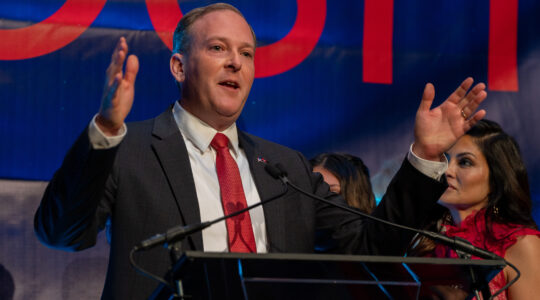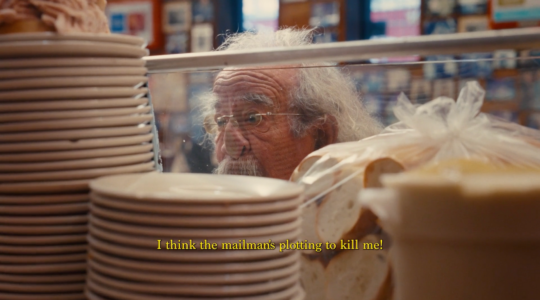When Margot Leverett began playing the clarinet as a child, she didn’t know where it would lead her.
She might not have guessed that it would become a career.
She couldn’t have guessed that it would bring her a new faith.
All she was looking for was an instrument she could carry.
Last week in a telephone interview, the 44-year-old musician recalled, “My family had already moved three times by the time I was in grade school, so I needed something small to take with me. I remember, I saw the movie ‘The Sound of Music’ and I watched Julie Andrews in the opening scene with her guitar case, carrying her little guitar, and I thought, ‘That’s me.’ ”
So when she entered the school band program in her Midwestern town, she settled on the equally portable clarinet.
That clarinet eventually would bring her a membership in the klezmer music community, first with the Klezmatics, later with Mikveh and other bands; that membership, in turn, led her to a major spiritual change.
Leverett recalled, “The music immersed me in the Jewish community. Because of that I was becoming involved in all the holidays and the people, and this became my community too. As I participated more and more I realized I needed the holidays and Shabbat. I also realized at some point that my Jewish life was depending on other people and I needed to make it happen for myself. So I began observing Shabbos at home, made my own seder. When I knew that I couldn’t get through another week without Shabbos, I realized that I had to convert.
“My upbringing was completely secular, with Santa Claus and the Easter bunny. Culturally my parents are very White-Anglo-Saxon-Protestant,” she said. “I finally realized that I needed a deeper spiritual connection, and the Jewish community provided it.”
Appropriately, Leverett’s latest project is something of a combination of those two worlds, the Jewish and the Anglo-Saxon-American. Margot Leverett and the Klezmer Mountain Boys make an unusual attempt to meld klezmer and bluegrass, two distinctly different types of ethnic music.
The clarinet is one of the backbones of klezmer, particularly as it has been played in the New World. But there isn’t much clarinet literature in bluegrass.
Actually, there isn’t any, as Leverett admits with a laugh.
Support the New York Jewish Week
Our nonprofit newsroom depends on readers like you. Make a donation now to support independent Jewish journalism in New York.
“There’s some clarinet in ‘old-time,’ which is the precursor of bluegrass, but if there’s any bluegrass clarinet, I haven’t heard it yet.”
One thing the two genres have in common is the prominence of fiddle players. In fact, it was fiddle music that got Leverett interested in this experiment in the first place.
“I’ve been interested in [American] fiddle music for a long time but nobody lets me do it because I play clarinet. And I wanted to try klezmer with a string band, getting away from accordion-bass-drums sound that’s so prevalent today.”
She talked with Barry Mittelhoffer, a New York-based mandolinist who plays in both genres, and they put together a rehearsal group.
Unfortunately, the first rehearsal date was scheduled for Sept. 13, 2001. The session never took place because, like so many people in New York, Leverett had to spend the next two weeks trying to find out if her friends and fellow musicians were even alive, let alone ready to play.
Happily, she persevered, and the band started playing together in December. It is a formidable ensemble, uniting some top players from both worlds: Leverett, Mitterhoff, Kenny Kosek on fiddle, bassist Marty Confurius, and guitarist Joe Selby. Confurius will be familiar to many Jewish Week readers from his long-time association with Andy Statman, another clarinetist who has played bluegrass (albeit on mandolin).
She recalled the first gathering with pleasure. “The sound was a deep rich soulful beautiful sound. I was glad to be in the same room with it. This music came from very deep inside.”
And listening to American fiddle music, starting but not ending with bluegrass, has made a deep impression on Leverett’s playing.
She explained, “Bluegrass fiddlers do things that clarinetists aspire to do. In country fiddling, [the fiddler is] a melody player who is also a rhythm player at the same time, and how they make that happen makes a person want to dance. At the same time, they do a lot of the same things klezmer clarinetists do — bending pitches in the middle of phrases, for example.”
Another element that the two musics share is an emphasis on collective improvisation. One would think that a band pulled together from two different worlds would take some time to gel in that vein, but Leverett said that hasn’t been the case with the Boys.
“There’s a lot of chemistry and electricity when people get together who haven’t played together before,” she explained. “It is really exciting to play with Kenny Kosek and to be inventing bluegrass clarinet. I had been listening to all the great bluegrass fiddlers on record, but to be in the room live with one of them is really exciting. And Kenny enjoys it too. I’m still playing the bluegrass tunes really straight and that allows him to really jam out on them. I’m the new kid on the block in bluegrass, but Barry and Joe have played together since high school, Marty’s been playing with these guys longer than he has with me, and he and I have played together for over 15 years.”
When Leverett converted to Judaism, her parents were very comfortable with the change. “My mother has actually been very supportive,” she said in an e-mail last week. “My brothers had more trouble with it but they’re starting to get used to it.”
Support the New York Jewish Week
Our nonprofit newsroom depends on readers like you. Make a donation now to support independent Jewish journalism in New York.
Hopefully both her old and new musical families will be able to make a similar adjustment for her new musical adventure.
Margot Leverett and the Klezmer Mountain Boys will be playing on Tuesday, Oct. 1 at 8 p.m. at The Knitting Factory, 74 Leonard St. (212) 219-3006. Later in the fall, the band will also be performing at the Big Apple Bluegrass Festival, at the Baggot Inn, 82 W. 3rd St., Nov. 8-9. Leverett will be hosting a series of monthly klezmer jam sessions beginning on Saturday, Dec. 8, at Astoria Center of Israel, 27-35 Crescent St., Queens; musicians and non-musicians alike are welcome.
The New York Jewish Week brings you the stories behind the headlines, keeping you connected to Jewish life in New York. Help sustain the reporting you trust by donating today.




